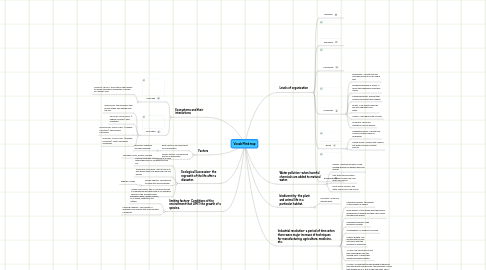
1. Ecosystems and their interactions
1.1. Food web
1.1.1. TROPHIC LEVELS- each step in the transfer of energy through an ecosystem is known as a trophic level.
1.2. Food chain
1.2.1. PRODUCER- the organisms that produce their own energy from the sun.
1.2.2. PRIMARY CONSUMER- (1 degree consmer)- eats producers
1.2.3. SECONDARY CONSUMER- (2 degree consumer)- eats primary consumers
1.2.4. TERTIARY CONSUMER- (3 degree consumer)- eats a secondary consumers
2. Factors
2.1. Biotic factors-The living ppart of an ecosystem.
2.1.1. Examples: migration and seed dispersal.
2.2. Abiotic factors- The nonliving part of an ecosystem.
2.2.1. Examples: flood, erosion, drought
3. Ecological Succession- the regrowth of the life after a diasaster.
3.1. Primary sucession- Start of life in an area where there was no life before and no soil.
3.2. Secondary succession- start of life in an area where there may have been life and has soil.
3.3. Pioneer species- First species to move into and ecosystem.
3.3.1. Exapmle: Lichen
3.4. Climax Community- this is a community that is in equilibrium and with little or no change in species in the following years.
4. limiting factors- Conditions of the environment that LIMIT the growth of a species.
4.1. Examples: water, energy, shelter, air, sunlight, predators, and mating.
4.2. Carrying Capacity- The number of indviduals of a species that an ecosystem can spport.
5. Levels of organization
5.1. Organism
5.2. Population
5.3. Communtiy
5.4. Ecosystem
5.4.1. Rainforests- a forest that has very high amounts of rain eaach year.
5.4.2. Temperate deciduous forest- a forest that seasonally loses their leaves.
5.4.3. Coniferous forest- a forest that contains trees that have needles.
5.4.4. Desert- a dry empty area that has little vegitation and water.
5.4.5. Tundra- a flat region with no trees.
5.4.6. Grassland- has much vegitation such as grasses.
5.5. Biome
5.5.1. Freshwater biome- a biome that contains mostly bodies of freshwater.
5.5.2. Marine biome- a biome that conains salt water and many aquatic animals.
